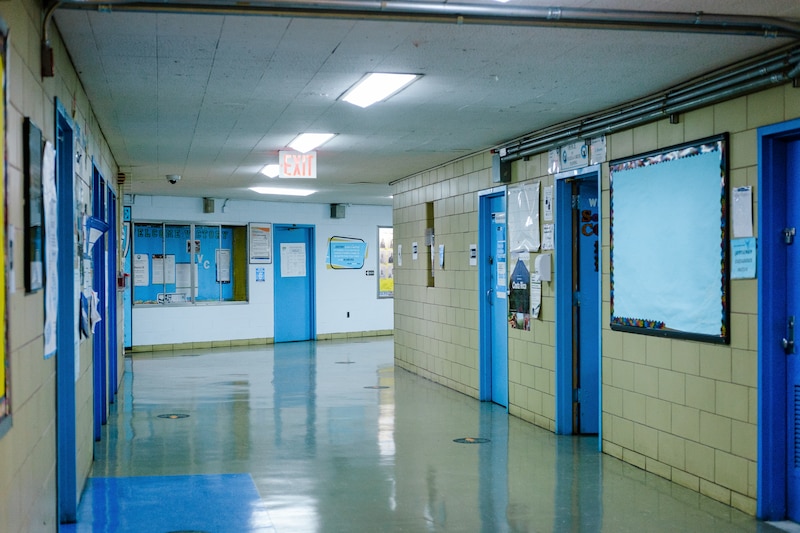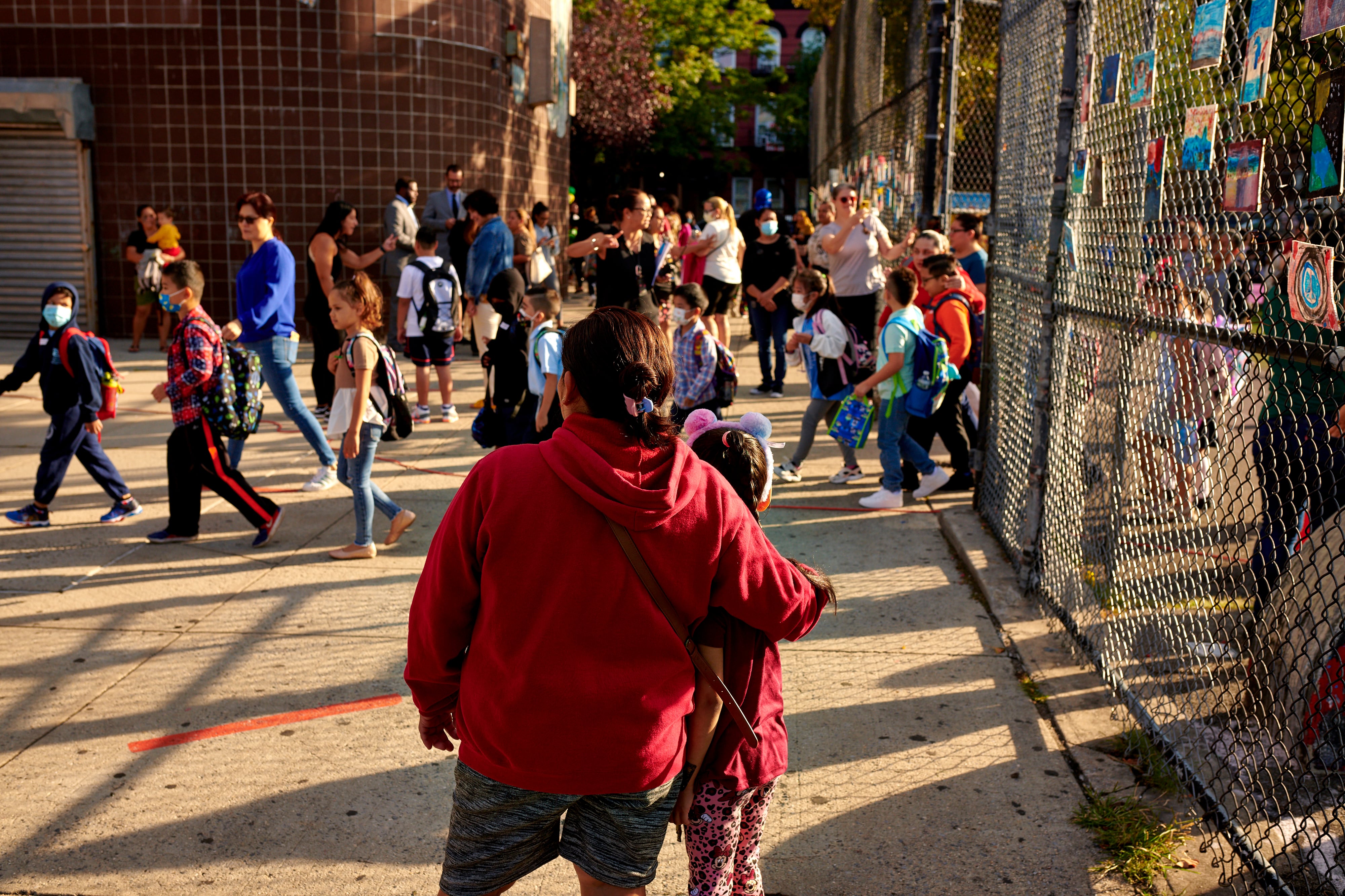Chalkbeat is a nonprofit news organization covering public education in communities across America. Subscribe to our free newsletter to keep up with how public education is changing: ckbe.at/national
Until now, it was one of the pandemic’s great mysteries: Where did the missing students go?
When classes resumed in fall 2020, several months after COVID struck, enrollment in the nation’s public schools had plummeted by more than a million students. It was the largest single-year decline since World War II. And defying hopes of a rapid rebound, enrollment barely budged the following year.
There have been clues about where students went, such as the steep rise in homeschooling, but a full explanation of the public school exodus has been elusive. Now, a new analysis offers a more comprehensive accounting — though one of its most striking findings is that tens of thousands of students remain absent from the available data.
“It’s really been enigmatic,” said Thomas Dee, a Stanford professor who conducted the analysis in collaboration with the Associated Press and data journalists at Stanford’s Big Local News project. “Where have these children gone?”
The data the team compiled point to two main drivers of the public school enrollment plunge: family choices and population changes. After public schools went remote, a portion of families switched their children to private schools or homeschool. At the same time, immigration slowed and many families fled big cities, causing the school-age population in some places to shrink.
The schooling changes and population shifts explain most of the enrollment drop — but not all of it, according to the analysis. Dee offers some possible causes of the unexplained decline: unregistered homeschooling, families opting out of kindergarten, and students who simply stopped attending school.
For students’ whose formal education ceased or failed to start during the pandemic, the learning loss continues.
“These data are telling us that there are learning disruptions that go beyond who is simply sitting in public schools,” Dee said.
Yet the number of unaccounted-for students and their current status is unclear. Most states don’t track all the students who leave public schools, and oversight of non-public education is minimal.
The new analysis “is beginning to shed light on a very important topic,” said Richard Welsh, a public policy and education professor at Vanderbilt University who was not involved in the study. Still, “we don’t have the data to get the complete picture.”
Here’s the latest on what we know — and still don’t know — about where students went during the pandemic.
Public schools lost a lot of students.
Public school enrollment fell by 3% during the first year of the pandemic, according to federal data. The largest decline since 1943, it wiped out a decade of enrollment growth.
The decrease left public schools with 49.4 million students in fall 2020 — about 1.4 million fewer than the previous fall.
The steepest declines were among the youngest students. From 2019 to 2020, prekindergarten enrollment plummeted by more than 20% and kindergarten enrollment fell by 9%, according to a federal analysis of preliminary data, which found much smaller declines in the later grades.
The decision to keep school buildings closed drove some families away, according to a separate study by Dee. School districts that remained fully virtual in fall 2020 faced bigger enrollment losses, he found.
In fall 2021, public school enrollment was flat. Students had stopped fleeing — but they weren’t returning.
“There was no bounce back,” Dee said.
It’s too early to know whether the tide is turning. Federal data for this school year is not yet available, and the most populous states — including California and Texas — have not reported their most recent enrollment counts.
However, about two dozen states have, according to the data tracking firm Burbio. Thirteen of those states saw enrollment increases in fall 2022, while 11 saw declines.
Homeschooling surged, and private schools grew modestly.
During the pandemic, public schools’ loss was other schools’ gain.
The share of families choosing to homeschool their children doubled in 2020, according to a Census survey. By that fall, about 11% of households with school-age children were homeschooling, up from 5.4% that spring and about 3% in prior years. The shift was especially dramatic among Black families, whose share of homeschooling families grew fivefold in 2020.
In the 21 states and the District of Columbia that track homeschooling, enrollment soared by 30% from fall 2019 to fall 2021, according to the Stanford and AP analysis.
“It was a destination of choice,” said Welsh, the Vanderbilt professor, adding that the expansion of remote work enabled some parents to try homeschooling.
Private schools saw a smaller bump. Their enrollment climbed just over 4% during that period, according to the analysis, which included data from 33 states and D.C. (Non-public school data can be spotty even in states that track it. For example, Colorado, which is included in the analysis, does not require private schools to provide student counts, and nearly 30% of the 700 private schools in a state directory didn’t report any enrollment data.)
Notably, private schools’ first grade classes ballooned in fall 2021, the analysis found, suggesting that some families who opted out of public kindergarten in 2020 decided to keep their children in private schools.
How the local public schools responded to the pandemic appeared to influence families’ school decisions. In a study of Michigan’s enrollment patterns, researchers found that more families opted to homeschool in districts that resumed in-person learning in fall 2020; in districts that stayed remote, more families moved to private schools.
“No matter what choice the public system made,” said Andrew Bacher-Hicks, a Boston University professor who co-authored the study, “they were going to lose some set of families.”
In Michigan, about half the students who exited the public schools in fall 2020 returned the following year, Bacher-Hicks said.
Nationwide, whether families will stick with their pandemic school choices remains to be seen. The most recent national data on non-public school enrollment is from 2019, and the Stanford-AP analysis ends in fall 2021.
In a recent survey of about 300 private schools, 55% reported enrollment gains this school year and 20% reported losses. A few states that released fall 2022 homeschool data saw enrollment increases, while others saw declines.
Welsh said it’s likely that some families who decided to homeschool at the height of the pandemic will reconsider.
“I do think there could be some buyer’s remorse,” he said.
The school-age population shrank, and families moved.

While families ditching public schools drew headlines, a less visible change also drove the enrollment drop: In many places, there were simply fewer children around to enroll.
The school-age population shifted in two big ways during the pandemic. First, it shrank nationwide by some 250,000 children, according to the Stanford-AP analysis, which relied on Census estimates in April 2020 and July 2021. Birth rates that have fallen for over a decade and a sharp drop in international immigration during the pandemic drove the decline.
Second, many families with children relocated during COVID. They were most likely to leave cities, often due to housing costs or health concerns. They also moved between states: California and New York lost the most children, while Texas and Florida gained the most.
The school district in Brockton, Massachusetts, a midsize city south of Boston, was hit by both trends: a falling birth rate and out-migration.
“Many families lost their jobs and struggled to pay rent and now are facing eviction,” said district spokesperson Jess Silva-Hodges, adding that many moved in search of cheaper housing. “The affordability of everything has been a challenge for our families.”
Across the 21 states with full datasets in the Stanford-AP analysis, population shifts explain 26%-36% of public schools’ pandemic enrollment decline. (The size of the effect depends on the length of the population estimate.) The effect was bigger in states such as New York, which lost some 60,000 school-age children. Population loss drove at least 40% of that state’s enrollment decline.
“On some level, the reduction in public school enrollment wasn’t just a flight from public schools,” Dee said, “it was a flight from communities.”
Researchers expect the population downturn to continue, leading the National Center for Education Statistics to project a 4% decline in school enrollment by 2030. Such projections have “sobering implications” for school finances and operations, Dee noted, including possible staff layoffs and school closures.
Federal COVID relief money has buffered most districts from the financial fallout of the recent enrollment declines — but those funds expire next year.
“There’s going to be lean years ahead,” said Silva-Hodges, adding that all districts must soon start “taking a hard look at their budgets.”
Many students are still missing.
In the new analysis, one of the most startling findings is that the numbers don’t add up.
In the 21 states and D.C. that had data on each trend, up to a third of the public school exodus — some 230,000 students — can’t be explained by population changes or increased private school or homeschool enrollment. At least on paper, those students are still missing.
The report suggests a few possible explanations. Some of the unaccounted-for students could be in unreported homeschool. More troublingly, some students might have left school during the pandemic due to family hardships or dissatisfaction with remote learning and never returned. But the report makes clear that data on the number of such students “are not widely available.”
However, the report does provide indirect evidence of a third possibility: that some families kept their children out of kindergarten during the first two years of the pandemic. Among the 21 states in the analysis and D.C., the share of unaccounted for students was significantly higher in places where kindergarten is not mandatory.
In other words, many of the missing students might have skipped kindergarten. While national data for this school year is not yet available, some states that have reported their fall enrollment figures saw increases in first grade, according to Burbio — a possible sign that students who sat out kindergarten have returned.
A final possibility is that some of the unexplained enrollment decline reflects incomplete data or measurement errors.
While the analysis is limited to states that track non-public school enrollment, it’s possible that some of the homeschool and private school figures are undercounts. And a few demographers Chalkbeat contacted raised concerns about aspects of the analysis, including its comparison of Census estimates to actual enrollment figures.
Dee called the concerns reasonable, but said the size of the missing student group — including nearly 152,000 unaccounted for students in California alone — suggests more is at play than measurement error. He also analyzed earlier data in New York and California and did not find such large unexplained enrollment changes before the pandemic.
While better data is needed to fully understand how many students have fallen through the cracks, Dee added, the fact that any students are unaccounted for is concerning.
“We’re so focused on how districts are engaging the kids in front of them,” he said. “But we’re missing the fact that some kids aren’t sitting there.”
Due to an update to one state’s enrollment figures, this story has been corrected to change the estimated number of students who aren’t accounted for in the data from 240,000 to 230,000.
Erica Meltzer and Amy Zimmer contributed reporting.
Patrick Wall is a senior reporter covering national education issues. Contact him at pwall@chalkbeat.org.






